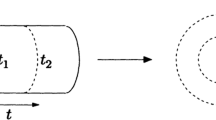Abstract
Within the framework of Relativistic Schrödinger Theory (RST), the scalar two-particle systems with electromagnetic interactions are treated on the basis of a non-Abelian gauge group U(2) which is broken down to the Abelian subgroup U(1)×U(1). In order that the RST dynamics be consistent with the (non-Abelian) Maxwell equations, there arises a compatibility condition which yields cross relationships for the links between the field strengths and currents of both particles such that self-interactions are eliminated. In the non-relativistic limit, the RST dynamics becomes identical to the well-known Hartree–Fock equations (for spinless particles). Consequently the original RST field equations may be considered as the relativistic generalization of the Hartree–Fock equations, and the “exchange interactions” of the conventional theory (induced by the anti-symmetrization postulate) do reappear here as ordinary gauge interactions due to a broken symmetry.
Similar content being viewed by others
References
S. Weinberg, The Quantum Theory of Fields (Cambridge University Press, 1995).
M. Carmeli, Classical Fields, General Relativity, and Gauge Theory (World Scientific, 2001).
B. Greene, The Elegant Universe. Superstrings, Hidden Dimensions and the Quest for the Ultimate Theory (Vintage Books, 2000).
G. Mahan, Many-Particle Physics (Plenum, New York, 1986).
E. E. Salpeter and H. A. Bethe, Phys. Rev. 84, 1232(1951).
M. Gell-Mann and F. Low, Phys. Rev. 84, 351(1951).
Tao Zhang, Zong-Chao Yan, and G. W. F. Drake, Phys. Rev. Lett. 77, 1715(1996).
F. Gross, Phys. Rev. C 26, 2203(1982).
R. H. Landau, Quantum Mechanics II (Wiley, New York, 1990), p. 439.
M. Sorg, J. Phys. A 30, 5517(1997).
S. Rupp and M. Sorg, Phys. Rev. A 63, 022112(2001).
M. Mattes, S. Rupp, and M. Sorg, Can. J. Phys. 79, 879(2001).
S. Rupp, S. Hunzinger, and M. Sorg, Found. Phys 32, 705(2002).
L. E. Ballentine, Quantum Mechanics (World Scientific, 1999).
W. Heisenberg, Zeitschr. Phys. 38, 411(1926); reprinted in Ref. 16.
I. Duck and E. C. G. Sudarshan, Pauli and the Spin-Statistics Theorem (World Scientific, 1998).
P. A. M. Dirac, Proc. Roy. Soc. (London) A 112, 661(1926); reprinted in Ref. 16.
D. T. Blochincev, Quantum Mechanics (Reidel, Dordrecht, 1964).
F. Selleri, Quantum Paradoxes and Physical Reality (Kluwer Academic, 1990).
R. Omnes, The Interpretation of Quantum Mechanics (Princeton University Press, 1994).
S. Pruß-Hunzinger, S. Rupp, and M. Sorg, “Geometry and topology of relativistic two-particle quantum mixtures, ” Preprint, 2002.
U. Ochs and M. Sorg, Gen. Rel. Grav. 28, 1177(1996).
S. Rupp, Phys. Rev. A 67, 034101(2003).
S. Kobayashi and K. Nomizu, Foundations of Differential Geometry (Interscience, 1963).
W. Greiner, Relativistic Quantum Mechanics (Springer, 2000).
T. Sigg and M. Sorg, Gen. Rel. Grav. 29, 1557(1997).
G. W. F. Drake, Atomic, Molecular, and Optical Physics Handbook (American Institute of Physics, 1996).
Author information
Authors and Affiliations
Rights and permissions
About this article
Cite this article
Verschl, M., Sorg, M. Relativistic Schrödinger Theory and the Hartree–Fock Approach. Foundations of Physics 33, 913–954 (2003). https://doi.org/10.1023/A:1025617527838
Issue Date:
DOI: https://doi.org/10.1023/A:1025617527838



